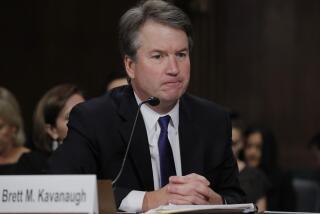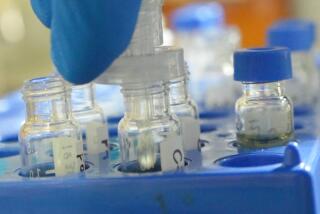Workers Portray FBI Lab as a Shoddy Shop
WASHINGTON â As described by some government technical analysts, the FBIâs world-renowned laboratory here sometimes was a chaotic scene:
Public tour groups filed through a hallway, kicking up dust, as delicate experiments were conducted nearby. Agents, fresh from the FBIâs gun range or bomb unit, passed through--perhaps unwittingly spreading residue that could jeopardize tests. Lab technicians sometimes ignored or violated scientific protocols, some examiners were unqualified to issue test reports and, in one case, an analyst enhanced his scientific knowledge by âviewing videos.â
Throughout the history of the FBI, the lab on the third floor of the J. Edgar Hoover Building here has enjoyed a reputation for precision and expertise. It not only was where federal agents sent their evidence but was also the place where law enforcement agencies from around the nation sought help in solving crimes.
The lab conducts more than 600,000 examinations a year for local, state and federal law enforcement agencies.
But for more than a year now, the Justice Departmentâs inspector general has been reviewing widespread allegations of abuse and shortcomings at the lab. Now, with a final report from the inspector general expected to be released as early as March, the FBI has already acknowledged problems, transferred some lab personnel and begun planning for a new facility at the FBIâs training academy in Quantico, Va.
A draft copy of the inspector generalâs findings was given to the FBI on Jan. 17, and the bureau is to respond by Feb. 20. The inspector generalâs office then will issue a final report.
What that report will say is not clear. What is clear from government documents obtained by The Times is that many current and former employees of the lab have told investigators about numerous flaws that they saw in the way criminal evidence was handled.
Several lab employees described a physical facility and professional culture that they thought lent itself to problems. They said tourists were escorted through a corridor of the trace-analysis section of the lab, a procedure that permitted outsiders to track in materials that could contaminate ongoing tests, they said.
Also using that carpeted walkway were bomb crews or agents who had just left the FBIâs explosives unit or gun range. There were concerns that they too could leave contaminants behind.
Frederick Whitehurst, a lab chemist who has been suspended and now is expected to testify for the defense in the Oklahoma City bombing case, said bomb-residue contamination was found in the lab in the summer of 1995.
The discovery came after analysts began examining debris taken to the lab from the Oklahoma City bombing site. Whitehurst was asked whether that was the only contamination problem inside the crime lab. âI know it wasnât,â he said.
However, government sources said Thursday that Whitehurstâs claim is irrelevant because the Oklahoma City bombing debris had already been tested.
Whitehurst also told the inspector general that in-house âswabbingsâ were conducted earlier that year, before the bombing, and that glassware, benches, workstations and other areas in the lab were found to be contaminated.
Lab workers said they also worried about ventilation ducts and other air shafts that could cause cross-contamination of some minute particles.
One analyst, Rick Hahn, told investigators that there were no rules for when protective clothing should be worn in the lab, and that he worried that cross-contamination of materials could occur. Often it was up to each examiner to decide what to do to prevent contamination.
Hahn also said that he learned more by teaching himself on the job than from hands-on training, and that he became proficient on a certain type of explosives examination by âviewing videos.â
David Williams, a supervisory agent in the explosives unit, told the inspector general that he did not think there were enough books or other publications to keep analysts up to date on some sciences, such as how to detect damage from certain types of bombs. He indicated that he simply relied on his own general knowledge.
And Whitehurst suggested that when technical instruments produced conflicting results, lab guidelines at times were unclear on how to proceed.
Under FBI policy, he said, a system was created in the lab where expertise is often informally âpassed down from teacher to studentâ and front-line examiners were discouraged from challenging official conclusions.
This week, senior FBI officials announced the suspensions of four lab employees, including two supervisors. But Weldon Kennedy, FBI deputy director, cautioned that the job actions were ânot done in retaliation for the actions of any employee.â
âThe actions were taken for good and valid reasons,â he said, âbased on the findings about some of their work by the inspector general and other information. These actions are fair and consistent with long-standing FBI policy and procedures.â
Two of those removed were Whitehurst and Williams.
Kennedy also revealed that the bureau decided three years ago to improve the lab--before the inspector generalâs investigation began. Along with constructing a new facility, he said, the bureau also will seek outside accreditation, which for the first time would allow non-government experts to occasionally inspect the FBIâs facility.
Kennedy also said the FBI âsharply disagreesâ with critics who contend that some criminal prosecutions may have been compromised because of problems at the lab.
âThe FBIâs goal,â he said, is âto maintain the laboratory on the cutting edge of law enforcement as a vital tool in efforts to protect the American people from crime.â
More to Read
Sign up for Essential California
The most important California stories and recommendations in your inbox every morning.
You may occasionally receive promotional content from the Los Angeles Times.











